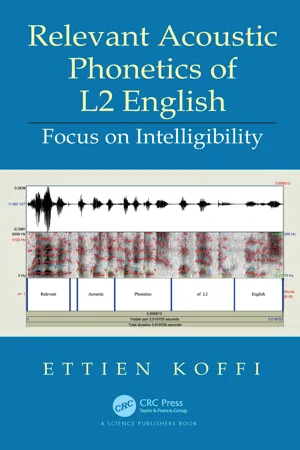
- 332 pages
- English
- ePUB (mobile friendly)
- Available on iOS & Android
About this book
Intelligibility is the ultimate goal of human communication. However, measuring it objectively remained elusive until the 1940s when physicist Harvey Fletcher pioneered a psychoacoustic methodology for doing so. Another physicist, von Bekesy, demonstrated clinically that Fletcher's theory of Critical Bands was anchored in anatomical and auditory reality. Fletcher's and Bekesy's approach to intelligibility has revolutionized contemporary understanding of the processes involved in encoding and decoding speech signals. Their insights are applied in this book to account for the intelligibility of the pronunciation of 67 non-native speakers from the following language backgrounds –10 Arabic, 10 Japanese, 10 Korean, 10 Mandarin, 11 Serbian and Croatian "the Slavic Group, " 6 Somali, and 10 Spanish speakers who read the Speech Accent Archive elicitation paragraph. Their pronunciation is analyzed instrumentally and compared and contrasted with that of 10 native speakers of General American English (GAE) who read the same paragraph. The data-driven intelligibility analyses proposed in this book help answer the following questions:
- Can L2 speakers of English whose native language lacks a segment/segments or a suprasegment/ suprasegments manage to produce it/them intelligibly?
- If they cannot, what segments or suprasegments do they use to substitute for it/them?
- Do the compensatory strategies used interfere with intelligibility?
The findings reported in this book are based on nearly 12, 000 measured speech tokens produced by all the participants. This includes some 2, 000 vowels, more than 500 stop consonants, over 3, 000 fricatives, nearly 1, 200 nasals, about 1, 500 approximants, a over 1, 200 syllables onsets, as many as 800 syllable codas, more than 1, 600 measurement of F0/pitch, and duration measurements of no fewer than 539 disyllabic words. These measurements are in keeping with Baken and Orlikoff (2000: 3) and in accordance with widely accepted Just Noticeable Difference thresholds, and relative functional load calculations provided by Catforda (1987).
Frequently asked questions
- Essential is ideal for learners and professionals who enjoy exploring a wide range of subjects. Access the Essential Library with 800,000+ trusted titles and best-sellers across business, personal growth, and the humanities. Includes unlimited reading time and Standard Read Aloud voice.
- Complete: Perfect for advanced learners and researchers needing full, unrestricted access. Unlock 1.4M+ books across hundreds of subjects, including academic and specialized titles. The Complete Plan also includes advanced features like Premium Read Aloud and Research Assistant.
Please note we cannot support devices running on iOS 13 and Android 7 or earlier. Learn more about using the app.
Information
1.0 Introduction
1.1 A Quick Overview of Acoustic Phonetics

We think of “speech” as an acoustic signal that is heard when people talk to each other. But that sound is the end result of a complex process, starting in the brain where thoughts are translated into language and muscle commands are sent to our vocal tract to shape it and get air moving through it. As the air moves through the slowly changing vocal tract, the right sounds will be produced in the right sequence so that they can be interpreted by the listener as speech. Once the muscles are activated, production is in progress and the physical properties of aerodynamics take over to produce a particular acoustic waveform.
Table of contents
- Cover
- Title Page
- Copyright Page
- Preface
- Acknowledgments
- Table of Contents
- List of Abbreviations
- 1. Review and Preview of Essential Concepts
- 2. Pictorial Definitions of Key Acoustic Phonetic Concepts
- 3. Preliminary Remarks on the Instrumental Assessment of Intelligibility
- 4. The Acoustic Vowel Spaces of L2 English
- 5. The Acoustic Phonetic Correlates of Stops in L2 English
- 6. The Acoustic Phonetic Correlates of Fricatives in L2 English
- 7. The Acoustic Phonetic Correlates of Nasals in L2 English
- 8. The Acoustic Phonetic Correlates of Approximants in L2 English
- 9. The Acoustic Phonetics of Complex Onset and Coda Clusters in L2 English
- 10. The Acoustic Phonetic Correlates of Lexical Stress in L2 English
- References
- Index
- About the Author